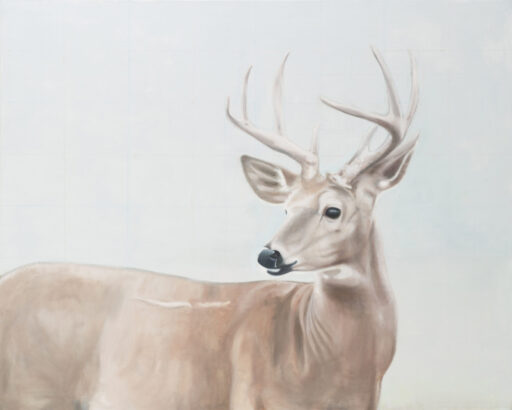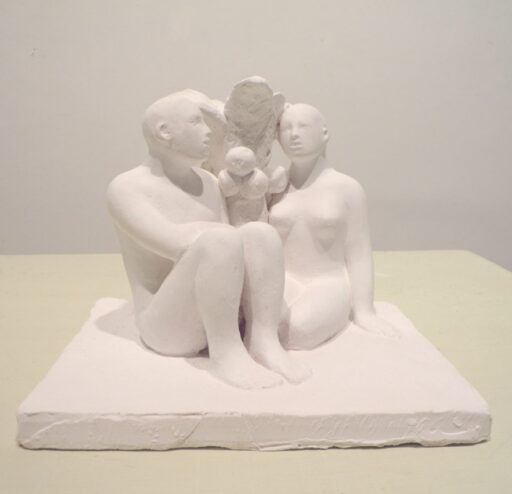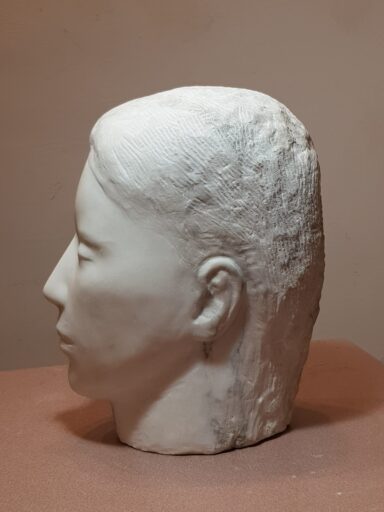Critical texts

Author: Rosario Schibeci
MARZIA GANDINI ARTIST IN NATURE
My works are the result of an unconscious process; there is no planning in how I choose my subjects. My works originate from images that strike me, which I then recompose and paint on canvas or shape in clay.
Amidst the historical and architectural beauty of Palazzo Taverna, on Via di Monte Giordano in Rome, there is a small studio made grand by the art of those who work there. Here, Marzia Gandini paints and sculpts, conveying emotions and states of mind through artworks that depict figures and landscapes in constant connection with nature.
It is a clear journey beyond the idea of separation of the individual in today's world, by observing and connecting with the life that pulses around us, in the vegetation and animals that surround us.
A long stay in the United States provided a rich educational experience before returning to Italy to collaborate with renowned galleries. Among these, a collective exhibition at the American Academy in Rome, curated by Martha Boyden, titled Artists’ Choice, where established artists invited emerging talents.
On that occasion, Marzia Gandini was invited by Sandro Chia and had the opportunity to present a large triptych, as well as a collaborative piece. We had the pleasure of meeting the artist in her studio, where we had the chance to admire both completed and in-progress works of great impact.
Marzia, how was your experience in New York in terms of your personal artistic research in both painting and sculpture?
«It was a very intense experience. My works were centered on the idea of loneliness and incommunicability in large urban centers. I took photos and then painted in oil on canvas, depicting people inside subway cars or waiting rooms at airports—places of transit and passage.»
«At the same time, I also made commissioned portraits. In my sculptures, the underlying theme was the idea of contact and separation: figures sometimes placed in dialogue, other times presented alone, fragments cast in plaster or fused in metal.»
«The core of my research has always been an investigation into the human dimension, which I represented through figures placed in urban settings or sparse spaces, such as in the dance series inspired by the Bill T. Jones dance company, which I had the opportunity to know during the Roma Europa Festival.»
«I lived for many years between Europe and the United States, and the concept of transience has been central to my work.»
Most people follow the “American dream” to succeed in the U.S. What made you decide to return to Rome, where you now reside permanently?
«The United States offers many opportunities; it is a very fluid society where everything moves fast, and sometimes it is difficult to find balance among so many stimuli.»
«New York is incredibly stimulating but also extremely tough and competitive: work is everything, and you try to give your best, often sacrificing everything else. There are major galleries that set trends, and museums host extraordinary exhibitions—art is central in New York.»
«I spent most of my time in my studio, but at the end of the day, I would meet friends at gallery openings, museums scattered throughout the city, or other events.»
«Before moving, I studied at the Academy of Fine Arts in Rome, then attended courses at the Sculpture Center in New York and worked as an assistant to several artists, including Izhar Patkin, Kim Crowley, Craig McPherson, and Cynthia Karasek.»
«Having trained in Italy, I always had classical art as a reference. In New York, I had to confront the multiplicity of contemporary art languages, which led me to explore artists working with different media.»
«A period of training abroad is certainly important: you come into contact with a different culture that forces you to be open and receptive to diversity, but it also presents many challenges. The people I met came from all over the world, yet there was always a common sense of sharing and exchange that transcended differences.»
«However, by 2001, I began to feel the desire to return to Europe—I missed my family and my roots. Then came September 11, the attacks, and the collapse of the Twin Towers. I was in Italy preparing a solo exhibition at Galleria Vetrina Contemporanea by Elisabetta Giovagnoni, and I decided to stay in Rome.»
Rosario Schibeci

Author: Elisabetta Giovagnoni
A man and a woman, with a tree between them offering its fruits. The immediate association is with the Garden of Eden, yet neither before nor after Eve took the Apple, defying the divine Prohibition and unknowingly condemning the masculine and feminine to never meet again without suffering.
“I will greatly multiply your pains and your pregnancies; with labor pains, you shall bear children. Your desires will turn towards your husband, and he shall rule over you.”
An “Encounter,” in this case, between the Feminine and the Masculine, in an eternal and infinite time, in an absolute Here and Now, untouchable by Good and Evil. A meeting where each faces the other, mirroring and contemplating one another, flowing in the energy, where only respect and empathy reign.
This is how the artist describes her piece:
“As they are placed side by side in an ideal garden, the two figures may suggest a possible encounter, a point of balance between the reasons of the heart and those of the mind, in a sort of mutual contemplation.
Through the representation of a male and a female figure, I would like to indicate the two aspects of the soul and a conceivable, perhaps possible, reconciliation and harmony between these two aspects—so distant from each other, yet fundamental and inseparable. Placed next to each other, as if in conversation, I would like them to express a dimension of dialogue and mutual respect.”
Through her works, Marzia Gandini gives shape to her emotions, and her art always tells emotions—whether depicting figures or landscapes—in a continuous exchange between perception and feeling. Strong yet at the same time impalpable, translated into painting through color, sometimes soft, sometimes intense, depending on whether the focus is on gazes or physical contact. In sculpture, instead, emotions are captured through the body language of the figures.
As in this absolute “Encounter” between the Feminine and the Masculine, where awareness, respect, and Unconditional Love reign supreme—both for the other and for oneself. Love is to be understood as the divine spark and the driving force of everything because if Man could balance and integrate his feminine and masculine sides, Unconditional Love would reign supreme: for oneself, for the other.

Author: Massimiliano Reggiani
“Is It EROS?” the two-person exhibition with Marzia Gandini at the atelier of Palazzo Taverna for Rome Art Week develops a reflection by the South Korean philosopher naturalized German, Byung-Chul Han: “Eros tears the subject from itself and turns it towards the Other… The narcissist sinks into the shadow of himself, until he drowns in himself…”.
Byung-Chul Han, author of Eros in Agony, is a professor of Cultural Theory at the Universität der Künste in Berlin. His thought addresses the desire to know, to open oneself to the other and the different: an inclusive and sensitive gaze that does not start from dogmas and does not develop barriers.
Marzia Gandini’s art, matured and developed on both sides of the Atlantic between the Old World of origins and the multicultural New York, crossroads of the contemporary, confronts Eros from a continental perspective: there is nothing of the Mediterranean Bacchic rite, of the exuberance of colors of a Dionysian dance. It is a meditation lasting a lifetime, from the sculpture studied at the Academy to the refinement in the marble workshops of Carrara, to the large American oil paintings, on the meaning of the body-space relationship.
Sculpting or carving a figure, in fact, goes far beyond the technical exercise of verisimilitude; depicting a body in painting also means having to contextualize it in an environment: this analysis is an invisible but essential part of Marzia Gandini’s creative act. The artist, in this case, does not work from a project, she possesses the technical abilities to shape the form — with pigments or volumes — but waits for reality to suggest the moment of contact, a moment she will then capture in the finished work.
“Today,” explains Marzia Gandini, “we live in a global society where everything is the same and standardized; even Eros, the vital desire, struggles to manifest itself. In this way, people are increasingly isolated, despite being constantly hyper-connected.”
“Is It EROS?” becomes the culmination of her research: capturing those rare moments when exchange and interaction occur. From the body, it draws out those parts that surrender to contact: the closeness of faces, the warmth of a simple presence conveyed through a hand cupped, protective, and reassuring. There is no interest in narration: her sculpture is neither heroic nor symbolic, the subject does not become a model of virtue but presence. The painting seeks to purify identity from confusion: the figures are not alone because they are maladjusted; they are cleansed of everything transient that might disturb the Artist’s gaze.
The emotion that most spontaneously arises in front of Marzia Gandini’s works is the human empathy for one’s own fragility and that of the other: seeking a bridge of glances between unknown beings — three worlds as different as human, animal, and plant — means seeking something beyond the hyper-connected normality analyzed by Byung-Chul Han. There is a universe made of silences, memories, unexpressed possibilities, and stories never lived but potential, therefore truer and more vivid than everything that inevitably passes, gathers dust, and disappears.
Marzia Gandini manages to rediscover in the contemporary the measure of classicism, deliberately erasing all those centuries of reasoning and studies that propel us forward with knowledge, deceiving us into thinking we can overcome the natural limits of our delicate physicality. A butterfly’s flight becomes the measure of the unmeasurable, of life that briefly settles on us without being governed, planned, or forced into the cage of reason.
Eros, the desire for a true and profound contact, requires a predisposition: listening, astonished attention towards the unpredictable that may ignite before our eyes. One must be open-hearted for wonder to make its way and become tangible, capable of shaking us: in the technological banality of the present, observing Marzia Gandini’s works brings sudden humanity even to the most distracted passerby.
Marzia Gandini has brought the message to its essence, finding the courage to admit that everything — in interaction — is fundamentally a pure desire for contact.
Massimiliano Reggiani
in collaboration with Monica Cerrito